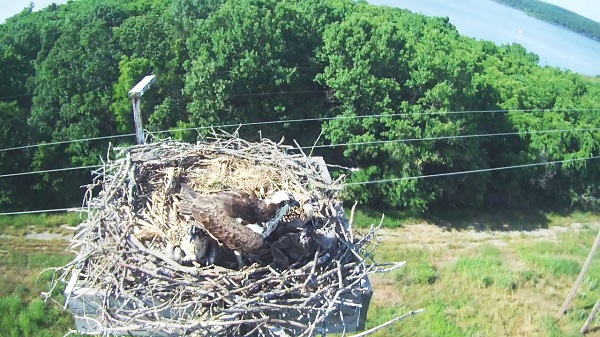Liberty Installs Nesting Boxes to Protect Osprey
Almost like clockwork, the osprey pair fly in to take up residence each year in the nesting box built for them above Stockton Lake in Stockton, Missouri.
There, their family has a 24/7 starring role on Liberty’s Osprey Cam – giving birdwatchers an up-close view of their daily activities. It’s an added bonus for a program that offers our feathered friends a safe nesting place while increasing service reliability for Liberty customers.
“(Osprey) are a form of migratory hawk species,” says Alexander Renfro, Liberty Engineer-Reliability. “They live by water, eat fish, and like to nest in high structures.”
Those high structures can include large trees or artificial structures – such as electric utility poles. The large nests are often built by the birds dropping sticks – some as large as 4- to 6-feet long – directly onto electric distribution and transmission lines, says Renfro.
In 2014, the birds lost a nest near Stockton Lake in Missouri after it came in contact with an energized line. The osprey were uninjured, but the fire caused damage to the transmission tower and line, interrupting electric service. The nesting pair then proceeded to rebuild their nest on the utility pole.
“It can cause problems for unprotected equipment and even the osprey themselves,” he says. “Due to the frequency of faults caused by osprey, Liberty needed to find a sturdier, more viable location for the nest.”
Following conservation laws and guidelines, Liberty crews in 2015 moved the nest to a new 4x4-foot nesting box standing approximately 70 feet high and about 50 feet away from the lines. A solar-powered camera was also installed, allowing for the live-stream of the birds’ nest.
“It’s what we believe is the best solution,” says Renfro. “It protects our physical equipment and protects the osprey. And people who are birdwatchers love to watch (the livestream).”
The cameras are powered by two solar panels. Infrared light illumination (which the birds cannot see) also provides a nighttime view of the nest.
Several nesting boxes have been installed throughout the service territory. Liberty is currently looking at other sites where they might be needed, as well as different types of structures that could be used.
“It’s the best solution for all parties – customers, the utility, and the birds,” said Shawn Stephens, Liberty Engineering-Standards Technician. “We can minimize our impact on the environment while providing reliable power.”

- Up to 24 inches long
- 5- to 6-foot wingspan
- Eat fish almost exclusively
- Called “fish hawks” or “fish eagles”
- 7- to 10-year lifespan; mate for life
- Lay 2-4 eggs, chicks hatch in about 9 weeks
- Both parents care for chicks

